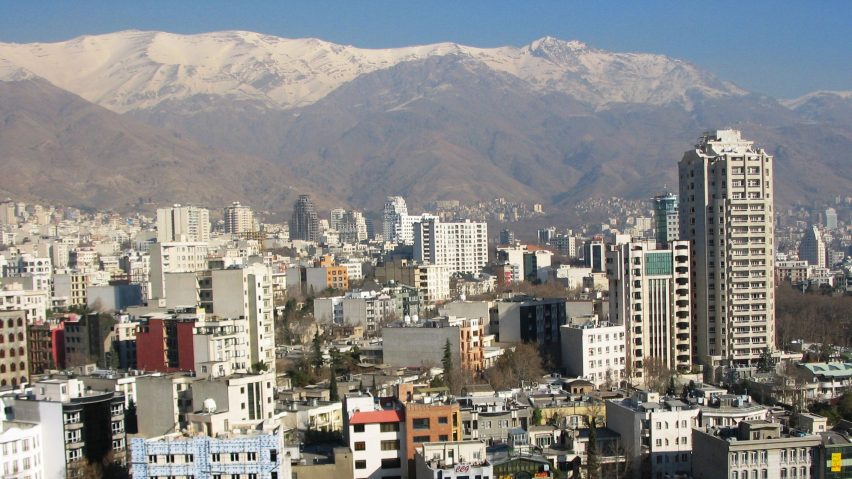
Iranian architects and designers "not working" in protest at government oppression
Architects and designers are finding ways to support the ongoing protests against the oppression of women in Iran despite a violent crackdown by security forces.
"Some of the studios, they have closed off their practice right now," leaders of an architecture studio in Iran, who preferred not to be named for their own safety, told Dezeen via an interpreter.
"They're not working. Some of them have put a statement out there that they're not going to work with any governmental organisation anymore."
Architects have been threatened
Unrest spread across Iran following the death in custody of Mahsa Amini, a 22-year-old woman arrested by morality police on 13 September for allegedly breaching rules requiring women to cover their hair with a hijab.
The studio said that people close to them in the architectural community and beyond have been directly affected by retaliatory police violence for supporting protests and that they were part of a group of architects who were shot at by police with "paint bullets" for attempting to join a demonstration.
Architecture and design studios have been releasing statements on Instagram condemning the Iranian government's actions, they added.
They said there have been rumours that influential Iranian architecture studios that have posted in support on Instagram have faced reprisals.
"On Instagram, architects, especially those with a lot of followers, they have been threatened, like whoever was supporting the protests," the sources said.
Projects stalled
The studio also reported that projects are stalled or being cancelled due to a lack of investors and the infeasibility of continuation due to the unrest.
"No one really wants to invest," said the studio. "[A cafe planned for the city centre] was in the middle of all these protests. The concept of having a cafe there right now, it doesn't really making any sense."
Members of the studio also teach and noted a drop in school attendance.
"The number of students has decreased from 13 people to seven people because no one wants to attend the classes anymore," they said.
"They didn't want to attend the classes because some of them are going to these protests and some of them are just aren't in a good situation mentally."
The studio said there is not a government-recognised organisation for architectural professionals in Iran through which they can formally voice their concerns.
However, they believe that the unrest presents opportunities for architects to consider how the spaces they design can create room for more democratic forums in the country.
"For architecture, space has always been a fundamental issue and whether we agree or not, it's a political issue," said the studio.
"The spatial structure defined by the government's point of view does not have the capacity to take a more inclusive and holistic approach to space," it continued.
"Everything is defined and perceived only through their own point of view."
Protestors use visual cues in support
Protestors have used various visual mediums to send messages to the Iranian authorities. In early October, the Washington Post reported that many significant fountains around Tehran had been dyed red.
Instagram posts from anonymous users within Iran also showed statues being painted in red.
View this post on Instagram
"I think graffiti on the wall is the most beautiful thing that is happening right now," said a New York-based Iranian designer, who also preferred not to be named.
Solidarity among international designers has played a role in spreading awareness throughout the world.
A number of designers created posters illustrating support for the rights of women in Iran and protests against the actions of the country's authoritarian government have occurred in Berlin, New York, Toronto and elsewhere.
Instagram vital source of information
Instagram continues to be a vital source of information about happenings on the ground in Iran for both national and international observers, according to the Iranian studio Dezeen spoke to.
"These days, people use social media to help or inform people in different cities, even though the internet is slowed down or cut off by the government and access to social media has been even more restricted," said the architecture studio.
"For example, social media has played an essential role in getting the news out on the reported shootings in Zahedan or the protest at Sharif University."
The New York-based designer said that sharing stories and raising awareness are two of the main things people can do to show solidarity.
She has been working with friends and colleagues to collate news about the protests and translate it into English on a website called Be The Voice.
"I think right now, the only thing that matters is just talking about what's happening in Iran," she told Dezeen.
The protests have continued despite explicit threats of repercussions from Iran's Revolutionary Guard.
"After the 1979 revolution, Iran has never reached the post-revolution era, and we are living in a constant revolutionary state after almost 44 years," said the Iranian studio.
"The recent events are the continuation of the same situation."
Images courtesy of Wikipedia commons.